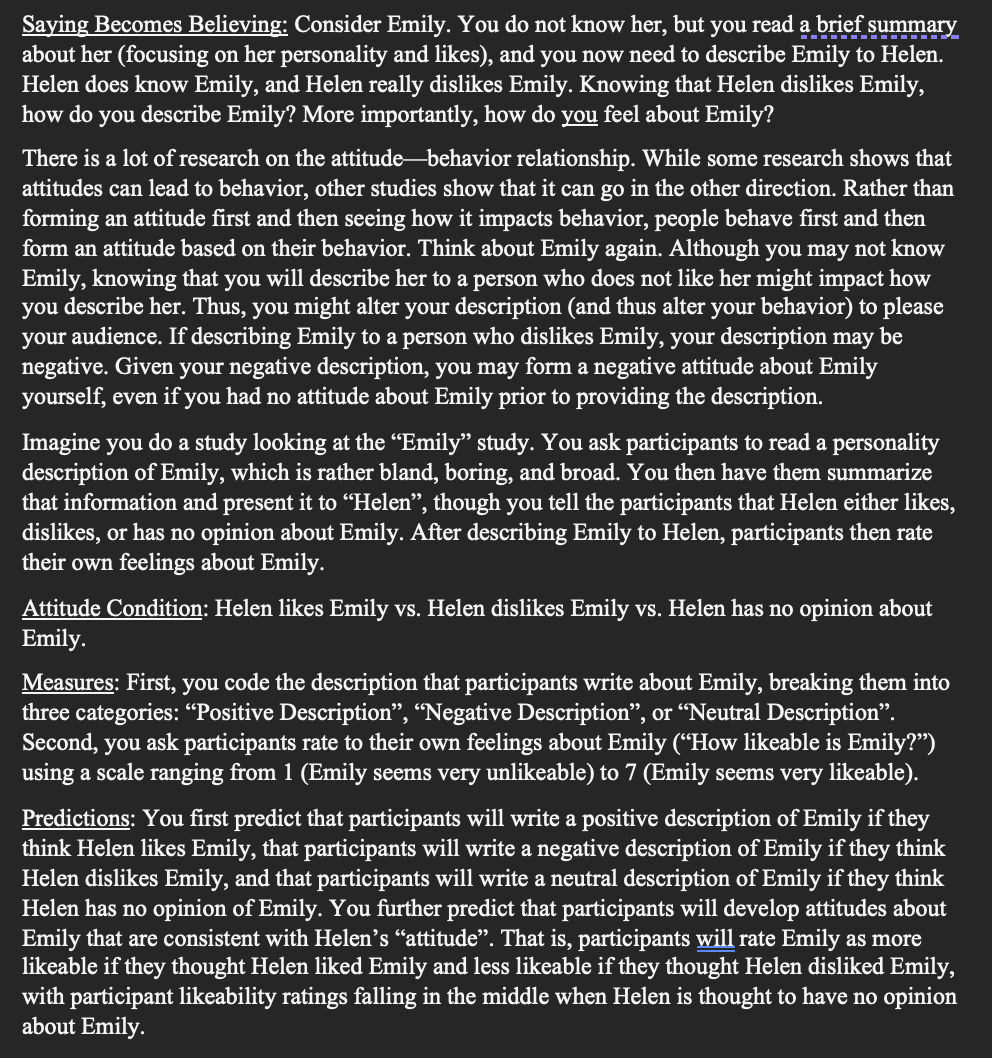Question
1). What is the main independent variable in this study, and how many levels are there for this independent variable? Choose the BEST option (

1). What is the main independent variable in this study, and how many levels are there for this independent variable? Choose the BEST option (.5 points)
A. IV: Participant Descriptions of Emily, two levels (Positive Description, Negative Description)
B. IV: Participant Feelings about Emily (1 = Emily seems very unlikeable to 7 = Emily seems very likeable)
C. IV: Attitude Condition, with two levels (Helen likes Emily, Helen dislikes Emily)
D. IV: Attitude Condition, with three levels (Helen likes Emily, Helen dislikes Emily, Helen has no opinion about Emily)
2). What are the dependent variables in this study, and what scale of measurement are they based on (using NOIR)? Choose the BEST option (.5 points)
A. DV #1: Participant descriptions of Emily: Nominal scale DV #2: Participant ratings of Emilys likeability: Nominal scale
B. DV #1: Participant descriptions of Helen: Nominal scale DV #2: Participant ratings of Helens likeability: Interval scale
C. DV #1: Participant descriptions of Emily: Nominal scale DV #2: Participant ratings of Emilys likeability: Interval scale
D. DV #1: Participant ratings of Emilys likeability: Nominal scale DV #2: Participant descriptions of Emily: Interval scale
3). You are going to run some data analyses using the DataAnalysisFIU#1EmilyFall.sav SPSS file in Canvas. Use your independent variable and your nominal dependent variable in the SPSS analysis. (Hint: Your scale of measurement for the nominal dependent variable should let you know which specific statistical test to use!). After running the test, choose the correct analysis, write-up, and conclusion from the options below (1.5 points)
A. We ran a chi square using Attitude Condition as the independent variable (Helen likes Emily, Helen dislikes Emily, Helen has no opinion about Emily) and participants description of Emily as the dependent variable. A significant effect emerged, 2(2) = 137.49, p
B. We ran a chi square using Attitude Condition as the independent variable (Helen likes Emily, Helen dislikes Emily, Helen has no opinion about Emily) and participants description of Emily as the dependent variable. A significant effect emerged, 2(6) = 137.49, p
C. We ran a chi square using Attitude Condition as the independent variable (Helen likes Emily, Helen dislikes Emily, Helen has no opinion about Emily) and participants description of Emily as the dependent variable. A significant effect did not emerge, 2(6) = 137.49, p =.10. There was no difference in Emily descriptions between the three conditions, indicating that Helens opinion of Emily did not impact how participants described Emily. Cramers V, which is appropriate for this design, was very weak. Participants did not adapt their descriptions of Emily to align with whether Helen liked, disliked, or had no opinion of Emily.
D. We ran a One-Way ANOVA using Helen Attitude Condition as the independent variable (Helen likes Emily, Helen dislikes Emily, Halen has no opinion about Emily) and participants description of Emily as the dependent variable. A significant effect emerged, F(2, 117) = 57.10, p M = 1.35, SD = 0.80) than in the Helen dislikes Emily condition (M = 2.10, SD = 0.44) and the Helen no opinion about Emily condition (M = 2.80, SD = 0.52), with more positive descriptions in the no opinion condition than in the dislikes condition. This indicates that participants actually had more negative opinions of Emily when Helen liked Emily, which is contrary to the predictions.
Saying Becomes Believing: Consider Emily. You do not know her, but you read a brief summary about her (focusing on her personality and likes), and you now need to describe Emily to Helen. Helen does know Emily, and Helen really dislikes Emily. Knowing that Helen dislikes Emily, how do you describe Emily? More importantly, how do you feel about Emily? There is a lot of research on the attitude - behavior relationship. While some research shows that attitudes can lead to behavior, other studies show that it can go in the other direction. Rather than forming an attitude first and then seeing how it impacts behavior, people behave first and then form an attitude based on their behavior. Think about Emily again. Although you may not know Emily, knowing that you will describe her to a person who does not like her might impact how you describe her. Thus, you might alter your description (and thus alter your behavior) to please your audience. If describing Emily to a person who dislikes Emily, your description may be negative. Given your negative description, you may form a negative attitude about Emily yourself, even if you had no attitude about Emily prior to providing the description. Imagine you do a study looking at the "Emily" study. You ask participants to read a personality description of Emily, which is rather bland, boring, and broad. You then have them summarize that information and present it to "Helen", though you tell the participants that Helen either likes, dislikes, or has no opinion about Emily. After describing Emily to Helen, participants then rate their own feelings about Emily. Attitude Condition: Helen likes Emily vs. Helen dislikes Emily vs. Helen has no opinion about Emily. Measures: First, you code the description that participants write about Emily, breaking them into three categories: "Positive Description", "Negative Description", or "Neutral Description". Second, you ask participants rate to their own feelings about Emily ("How likeable is Emily?") using a scale ranging from 1 (Emily seems very unlikeable) to 7 (Emily seems very likeable). Predictions: You first predict that participants will write a positive description of Emily if they think Helen likes Emily, that participants will write a negative description of Emily if they think Helen dislikes Emily, and that participants will write a neutral description of Emily if they think Helen has no opinion of Emily. You further predict that participants will develop attitudes about Emily that are consistent with Helen's "attitude". That is, participants will rate Emily as more likeable if they thought Helen liked Emily and less likeable if they thought Helen disliked Emily, with participant likeability ratings falling in the middle when Helen is thought to have no opinion about Emily. Saying Becomes Believing: Consider Emily. You do not know her, but you read a brief summary about her (focusing on her personality and likes), and you now need to describe Emily to Helen. Helen does know Emily, and Helen really dislikes Emily. Knowing that Helen dislikes Emily, how do you describe Emily? More importantly, how do you feel about Emily? There is a lot of research on the attitude - behavior relationship. While some research shows that attitudes can lead to behavior, other studies show that it can go in the other direction. Rather than forming an attitude first and then seeing how it impacts behavior, people behave first and then form an attitude based on their behavior. Think about Emily again. Although you may not know Emily, knowing that you will describe her to a person who does not like her might impact how you describe her. Thus, you might alter your description (and thus alter your behavior) to please your audience. If describing Emily to a person who dislikes Emily, your description may be negative. Given your negative description, you may form a negative attitude about Emily yourself, even if you had no attitude about Emily prior to providing the description. Imagine you do a study looking at the "Emily" study. You ask participants to read a personality description of Emily, which is rather bland, boring, and broad. You then have them summarize that information and present it to "Helen", though you tell the participants that Helen either likes, dislikes, or has no opinion about Emily. After describing Emily to Helen, participants then rate their own feelings about Emily. Attitude Condition: Helen likes Emily vs. Helen dislikes Emily vs. Helen has no opinion about Emily. Measures: First, you code the description that participants write about Emily, breaking them into three categories: "Positive Description", "Negative Description", or "Neutral Description". Second, you ask participants rate to their own feelings about Emily ("How likeable is Emily?") using a scale ranging from 1 (Emily seems very unlikeable) to 7 (Emily seems very likeable). Predictions: You first predict that participants will write a positive description of Emily if they think Helen likes Emily, that participants will write a negative description of Emily if they think Helen dislikes Emily, and that participants will write a neutral description of Emily if they think Helen has no opinion of Emily. You further predict that participants will develop attitudes about Emily that are consistent with Helen's "attitude". That is, participants will rate Emily as more likeable if they thought Helen liked Emily and less likeable if they thought Helen disliked Emily, with participant likeability ratings falling in the middle when Helen is thought to have no opinion about EmilyStep by Step Solution
There are 3 Steps involved in it
Step: 1

Get Instant Access to Expert-Tailored Solutions
See step-by-step solutions with expert insights and AI powered tools for academic success
Step: 2

Step: 3

Ace Your Homework with AI
Get the answers you need in no time with our AI-driven, step-by-step assistance
Get Started


